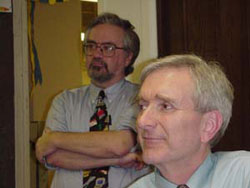Model School Library: teaching with technology
Way in the back of the fifth floor of Milbank Memorial Library, tucked away in the far corner is a room designed to bring technology and teaching together. The Resource Center's PT3/K-12 Demonstration Laboratory was designed to provide librarians, faculty, students and the staff of Teachers College with computer stations housing a variety of software programs that combine learning with fun.
On November 2nd, those involved in its creation held an opening demonstration of the laboratory. Jennifer Govan, Assistant Director at the Library, welcomed the group, saying "It is a special day for us. We are happy to be able to open this lab after so much teamwork." Ideally, she added, they would like the lab to be twice the size with many more resources.
Professor Howard Budin, who was also involved in the lab's creation, added that for a long time, Teachers College has not "had a resource to show our students who are going to be teachers how to use technology in the classroom." Thanks to a grant from the federal government aimed at preparing future teachers, along with contributions from the TC administration and the Milbank Library, the idea for the lab became a reality.
On the walls of the room hang posters and banners that correspond to a subject-designated workstation. A poster about fractions is placed near the math computer, a banner about ecology near the science computer and posters of writing styles and handwriting are by the English Language Arts computer. The lab has eight workstations in all, comprised of four PCs and four Macintosh computers. Each provides access to the Center's collection of model K-12 software as well as to general information and research resources in education, psychology, and the health sciences. All are fully connected to the Internet. Software is primarily on the elementary and middle school levels and is representative of the major content areas.
Representatives from the Library demonstrated samples of the software that is available to the lab's users. Rémi Castonguay, Bibliographer and Multimedia Specialist, presented Making More Music, a program that aims to introduce students to how music is composed. A student can designate notes on several stanzas with different instruments playing each. When the composition is complete, the program will play one stanza at a time or all together. Other sections of the program work with melody and rhythm and transform the process into a game.
Irina Poznansky, Resource Center Librarian, demonstrated SIRS Discover, an online database used for social studies assignments. The database contains full-text articles and graphics on history, current events and language arts from more than 1,400 publications. There are a variety of ways to search, including reading level, relevance or date. A tutorial describes every possible teaching and usage of the program. Text and photos from the database can be accessed and then sent to the user's e-mail address.
Govan presented a demonstration of the program called Rainforest, a science program that is designed to provide experience in team work, budgeting, research, and presentation of information. Each team consists of four persons in the roles of ecologist, ethnobotanist, chemist, and taxonomist. Two cases are available to choose from-"The Case of the Disappearing Durians" and "The Search for the Lost Compound." Students work from video presentations of the case and booklets that provide information. Wrong answers cost the team money and resources to continue with their work.
Judith Cramer, TC's Educational Technology Specialist, presented mathematics software designed by MIT graduates. Cramer demonstrated The Logical Journey of the Zoombinis, which engages younger students in observation and logic skills. The Zoombinis are creatures with no arms that are pressed into providing manual labor by other creatures. The students are assigned to help the Zoombinis escape. A higher version called YOIKS! is available for middle school students and is, according to Cramer, "quite difficult."
By the time of the opening, the lab had already hosted a group of curriculum librarians and had held one formal class demonstration. "We hope more people will come visit us," Govan said.
A listing of software acquisitions available at the lab is available at the Library and further information is available on the Web at http://lweb.tc.columbia.edu/cs/modelsl/.
Published Monday, May. 20, 2002
